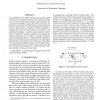Free Online Productivity Tools
i2Speak
i2Symbol
i2OCR
iTex2Img
iWeb2Print
iWeb2Shot
i2Type
iPdf2Split
iPdf2Merge
i2Bopomofo
i2Arabic
i2Style
i2Image
i2PDF
iLatex2Rtf
Sci2ools
83
Voted
ISBI
2007
IEEE
2007
IEEE
A Decision-Theoretic Approach to Transillumination Imaging in Biological Mediums
The tradeoffs between ballistic imaging (time-gated imaging of first-arrival, unscattered photons) and conventional imaging for resolving tumors in biological scattering media are examined. For ballistic imaging, closed form expressions are derived to characterize the resolvability using five degrees of freedom (laser intensity, scattering coefficient, thickness of medium, false alarm rate, and number of observations). For conventional imaging, a numerical approximation is used to find the asymptotic resolution using the scattering and absorption coefficients of the medium. Using the characterizations of both approaches, a decision-theoretic approach to determining the minimum resolvable object size is developed, which provides clear guidelines as to when time-gated ballistic imaging methods offer advantages over conventional imaging. The theoretical predictions are validated through a realistic simulation of tumors in breast tissue.
Ballistic Imaging | Conventional Imaging | ISBI 2007 | Medical Imaging | Time-gated Ballistic Imaging |
| Added | 03 Jun 2010 |
| Updated | 03 Jun 2010 |
| Type | Conference |
| Year | 2007 |
| Where | ISBI |
| Authors | Brian Eriksson, Robert Nowak |
Comments (0)

